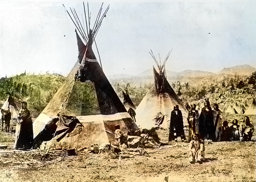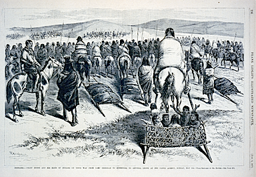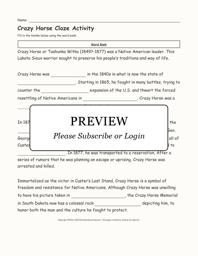Sitting Bull was a Lakota Native American chief, the last chief to surrender to the U.S. government.
Introduction
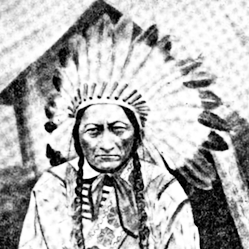
Sitting Bull
Sitting Bull (1831-1890) was a Lakota Native American chief and the last chief to surrender to the U.S. government. A great military leader, the Sioux tribes of the Great Plains coalesced under his leadership, culminating in the Great Sioux Wars of the 1870s (which included the 1876 Battle of the Little Bighorn).
Early Life
Sitting Bull, or Tatanka Iyotanka, was born in 1831 in what is now the state of South Dakota. From as early as 14, he fought and hunted for his Lakota tribe. He took after his father, Returns-Again, who was renowned as a great warrior.
It wasn’t long before Sitting Bull also became known for his courage. Much of this was shown in his fighting to halt the United States’ relentless western expansion, which drove directly into Native American territories. In the 1860s he first came across the white settlers. The interactions were mainly uprisings and battles, sometimes resulting in other tribes being cast into reservations. In 1864 he participated in the Battle of Killdeer Mountain, and the fighting continued into the 1870s.
Clash of Cultures and the Little Bighorn
As U.S. territory spread, Sitting Bull and the Native Americans moved further west. This accomplished two goals: avoiding the advancing white settlers and getting closer to herds of buffalo.
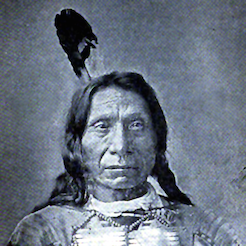
Red Cloud, the chief before Sitting Bull
Red Cloud, the chief before Sitting Bull, became unpopular with many because of the Fort Laramie treaty, which forced many Native Americans into reservations. In stark contrast, Sitting Bull took a leading role in risings against the U.S. government during this period. Partly due to the popularity of this, he rose to prominence as a medicine man, and he was named the “head chief of the Lakota nation” in 1868. All of this made a violent, major encounter with U.S. troops nearly inevitable.
The situation was exacerbated when gold was found in South Dakota’s Black Hills. These Hills were defined as sacred land to the Native Americans in the Fort Laramie treaty, but the American government and prospectors ignored this and planned to grab the disputed area. They also proclaimed that the Lakota had to be in reservations by 1876.
Needless to say, Sitting Bull and his supporters, including the famous warrior Crazy Horse, took offense. They set about attacking U.S. General George Crook and other cavalry who had positioned themselves in the Black Hills. The Battle of the Rosebud resulted in a Native American victory, but the key ambush was still to come. The year 1876 also saw the Battle of the Little Bighorn, known as Custer’s Last Stand.
Lieutenant Colonel George Armstrong Custer and his Seventh Cavalry were dwarfed by the thousands of Native Americans they faced. This, combined with Custer’s strategic mistakes, resulted in a massacre of the U.S. troops.
Although Sitting Bull was not actually leading the warriors, he had led prayers prior to the battle and had announced visions of the victory. Many credited their triumph to his actions as their leader. Unfortunately, partly due to this perception, Sitting Bull found that the U.S. army was then pursuing him (along with Crazy Horse and the various tribal chiefs involved). Fearful for his life, he went to Canada in 1877. Sitting Bull ventured back into the U.S. in 1881 and gave himself up to the U.S. government, which put him in Fort Randall and then Standing Rock Reservation.
Standing Rock Reservation
In his last few years, Sitting Bull still sought to protect the territory of Native Americans and to preserve their way of life. Interestingly, he also got a job in 1885, touring in Buffalo Bill Cody’s Wild West show. But Sitting Bull still rejected the new American society; he practiced polygamy and mantained his role as a holy man. This reached a crest in 1890, when the idea of a Ghost Dance gained a sudden popularity in Standing Rock Reservation. This Dance was associated with a belief that the Native American dead would come back to life, that the buffalo would roam the plains once more, and that the white Americans would vanish from their lives. Although it’s uncertain if Sitting Bull participated in these Dances, he refused to use his leadership to curb its popularity. The U.S.—fearing an uprising—decided to bring him in, but a small battle broke out, and a number of people on both sides were killed, including Sitting Bull.
More on Native Americans
Totem poles are huge wooden columns which were made by Native Americans along the Pacific coast of North America. Traditionally, each totem pole tells the story of a Native American family’s ancestral spirits and family history, pictured in human and animal form.
Native Americans lived in many different types of housing. Read about tipis, grass houses, wattle-and-daub houses, pueblos, wigwams, longhouses, plank houses, and even igloos!
A printable worksheet on Pocahontas (1595?-1617), with a short biography, a picture to color, and questions to answer.
Answers: 1. Chief Powhatan, 2. John Smith, 3. Jamestown, 4. John Rolfe, 5. England.
Chief Pontiac (1720-1769) was a great leader of the Ottawa Indian tribe. He organized his and other tribes in the Great Lakes area to fight the British, in what is known as Pontiac’s War.
Sacajawea or Sacagawea (1788-1812) was a Shoshone Indian giude, interpreter, and negotiator for Lewis and Clark on their exploratory expedition to the U.S. West. She traveled with them from North Dakota to the Oregon coast and back.
Read about Sitting Bull (1831-1890), the courageous Lakota leader. He was the last Native American chief to surrender to the U.S. government.
Fill in the blanks in this printout, which is a short biography of the Native American leader Sitting Bull. He was the last chief to surrender to the U.S. government.
Word bank: battle, Canada, expansion, father, South Dakota, Stand, courageously, government, surrender, Custer, reservations, warrior.
Read about Crazy Horse or Tashunka Witko (1849?-1877), a Lakota Sioux warrior who was a leader in the Native American victory over the U.S. government in the Battle of the Little Bighorn, Custer’s Last Stand.
Fill in the blanks in this short biography of the Native American warrior Crazy Horse, who was victorious over Gen. Custer in the Battle of the Little Bighorn.
Word bank: American, army, Bighorn, born, brave, Custer, photographs, reservations, sculpture, South Dakota, surrender, westward.
These printable graphic organizer worksheets can be used to organize material for reports on Native Americans. Includes each of: Canada/Alaska, the U.S., North America, Central America, and South America. Each region has a simple graphic organizer and a more complex graphic organizer.
Find words relating to Native Americans in this wordsearch puzzle. Look up, down, left, right, and diagonally! The PDF file includes both the word-search puzzle and the answer key.
Word bank: Sitting Bull, Powhatan, Sacajawea, Red Cloud, Crazy Horse, Ottawa, Lakota, Ghost Dance, Pontiac, Tribes, Sioux, Pocahontas, Chief, Little Bighorn
Make a tepee, a totem pole, a Kachina doll, a rattle, a dream catcher, and a paper canoe! Or combine a number of these simple crafts on a Native American bulletin board for a visually exciting display.

